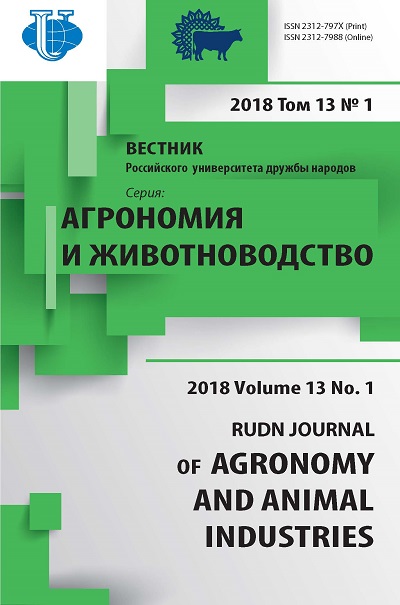The study of morphological and biochemical parametres of Amaranthus tricolor L. Valentina variety
- Authors: Platonova SY1, Peliy AF1, Gins EM1, Sobolev RV1, Vvedenskiy VV1
-
Affiliations:
- Рeoples’ Friendship University of Russia (RUDN University)
- Issue: Vol 13, No 1 (2018)
- Pages: 7-13
- Section: Crop production
- URL: https://agrojournal.rudn.ru/agronomy/article/view/18078
- DOI: https://doi.org/10.22363/2312-797X-2018-13-1-7-13
- ID: 18078
Cite item
Full Text
Abstract
Morphometric and biochemical indices of the red-colored Amaranthus tricolor L. Valentina variety were studied, the content of the reduced form of vitamin C, the amaranthine pigment in roots, leaves, stems and inflorescences was determined. Studies have shown the presence of a high concentration of vitamin C in the leaves of amaranth both in the open ground (195 mg%) and in the film greenhouse (176 mg%). In the leaves of amaranth of different varieties of the species Amaranthus tricolor , a large amount accumulates a secondary compound - an antioxidant - amaranthine. The red-violet color of the inflorescences is due to the presence in the vegetative organs of the plant of the red-violet pigment of amaranthine. It is important to note that the amaranth Valentine variety have found substances with antioxidant activity: ascorbic acid, selenium, carotenoids, methionine. In the largest amount, amaranthine is found in the inflorescences (2.18 mg/g) and leaves (1.41 mg/g). Its predecessors are D-glucose and L-tyrosine - photosynthetic metabolites, which are used in growth processes and in the biosynthesis of amaranthine In red-colored plants of the genus Amaranthus , betacianin-amaranthine is 5-O-glucuronidoglucoside betanidine. Leaves with a high content of red-violet pigment amaranthine used in the production of food additives-dyes Amvita and Amphicra, used in the food concentrates industry. These additives, due to their antioxidant properties, enhance immunity and have immunomodulatory activity. Extraction of amaranth leaves in H2O revealed high rates of antioxidant activity (CCA from 1.81 mg EQ GK/g). The low gluten content makes amaranth an extremely valuable and useful for functional food.
About the authors
S Y Platonova
Рeoples’ Friendship University of Russia (RUDN University)
Author for correspondence.
Email: Svetlana.Platonova.00@mail.ru
аспирант агробиотехнологического департамента Аграрно-технологического института Российского университета дружбы народов
Miklukho-Maklaya st., 6, Moscow, Russia, 117198A F Peliy
Рeoples’ Friendship University of Russia (RUDN University)
Email: kaluga-peliy@yandex.ru
аспирант агробиотехнологического департамента Аграрно-технологического института Российского университета дружбы народов
Miklukho-Maklaya st., 6, Moscow, Russia, 117198E M Gins
Рeoples’ Friendship University of Russia (RUDN University)
Email: Katya.888888@yandex.ru
магистрант агробиотехнологического департамента Аграрно-технологического института Российского университета дружбы народов
Miklukho-Maklaya st., 6, Moscow, Russia, 117198R V Sobolev
Рeoples’ Friendship University of Russia (RUDN University)
Email: maestro1994liveru@mail.ru
магистрант агробиотехнологического департамента Аграрно-технологического института Российского университета дружбы народов
Miklukho-Maklaya st., 6, Moscow, Russia, 117198V V Vvedenskiy
Рeoples’ Friendship University of Russia (RUDN University)
Email: vaval-ved@yandex.ru
кандидат сельскохозяйственных наук, доцент, директор агробиотехнологического департамента Аграрно-технологического института Российского университета дружбы народов
Miklukho-Maklaya st., 6, Moscow, Russia, 117198References
- Kononkov P.F., Gins V.K., Gins M.S. Amaranth promising culture of XXI century. Moscow: Publishing house of Russian University of friendship of peoples. 1999.
- Kononkov P.F., Pivovarov V.F., Gins M.S., Gins V.K. Introduction and selection of vegetables to create a new generation of functional foods actions. M.: Russian University of Peoples’ Friendship. 2008.
- Shafigullin D.R., Pivovarov V.F., Gins M.S. The Peculiarities of variations of signs of precocity of vegetable and grain soybean forms. Russian agricultural science. 2017. № 5. P. 18—24.
- Shafigullin D.R., Gins M.S., Romanova E.V., Borodin D.B. A study of precocity in the collection material of soybean. Vestnik Orel State Agrarian University. 2017. № 3 (66). P. 56—62.
- Kononkov P.F., Gins V.K., Pivovarov V.F., Gins M.S., Bunin M.S., Meshkov A.V., Terekhova V.I. Vegetables as a product of functional nutrition. M.: Capital printing house. 2008.
- Vysochina G.I. Amaranth (Amaranthus L.) chemical composition and prospects of use. Chemistry of vegetable raw materials. 2013. №. 2. P. 5—14.
- Karavaev V.A., Gunar L.E., Myakinkov A.G., Gins M.S., Glazunova S.A., Levykina I.P., Lepeshkin F.D. Slow induction of fluorescence and barley productivity treated with supercritical fluid extract of amaranth. Biophysics. 2012. Т. 57. № 4. P. 662—664.
- Baikov A.A., Gunar L.E., Gins M.S., Glazunova S.A., Karavaev V.A., Levykina I.P. Photosynthetic activity and productivity of barley treated with supercritical fluid extract of amaranth. In the collection: The role of physiology and biochemistry in the introduction and selection of vegetable, fruit and berry and medicinal plants. Moscow. 2011. P. 13—15.
- Gins V.K., Piunkova S.A., Konichev A.S., Gins M.S., Pivovarov V.F., Baikov A.A., Gorbatovskaya E.A., Romanova E.V., Kuznetsova L.V. Insecticidal action of metabolites of amaranth extracts. New and non-traditional plants and prospects for their use. 2016. №. 12. P. 191—195.
- Gins M.S., Kharchenko V.A., Gins V.K., Baikov A.A., Kononkov P.F., Ushakova I.T. Antioxidant characteristics of green and spicy-aromatic cultures. Vegetables of Russia. 2014. № 2 (23). P. 42—45.
- Mamedov M.I., Pyshnaya O.N., Baikov A.A., Pivovarov V.F., Dzhos E.A., Matyukina A.A., Gins M.S. The composition of antioxidants in fruits Capsicum spp. for the production of biotroblated products. Agricultural Biology. 2017. P. 52. № 5. P. 1021—1029.
- Sapozhnikova E.V., Dorofeeva L.S. Determination of ascorbic acid content in stained plant extracts by the iodometric method. Canning and vegetable drying industry. 1966. № 5. P. 29—31.
- Gins M.S., Pivovarov V.F., Gins V.K., Baikov A.A., Platonova S.Y., Gins E.M. Content and pigment composition of autotrophic and heterotrophic amaranth leaf tissue of A. tricolor L. species. Vegetables of Russia. 2016. № 3 (32). P. 79—83.
- Gins M.S. Biologically active substances of amaranth. Moscow: Peoples’ Friendship University of Russia. 2002.
- Khandaker L., Ali M.B., Oba S. Total polyphenol and antioxidant activity of red amaranth (Amaranthus tricolor L.) as affected by different sunlight level. Journal of the Japanese Society for Horticultural Science. 2008. Т. 77. №. 4. P. 395—401.
Supplementary files















